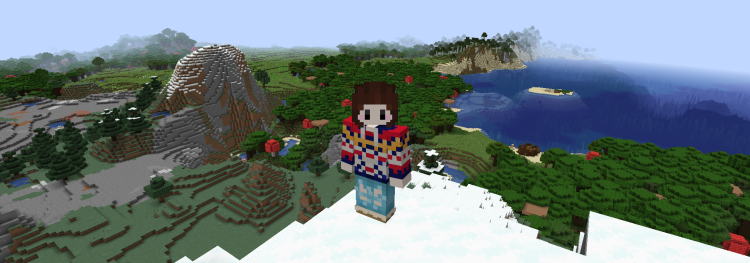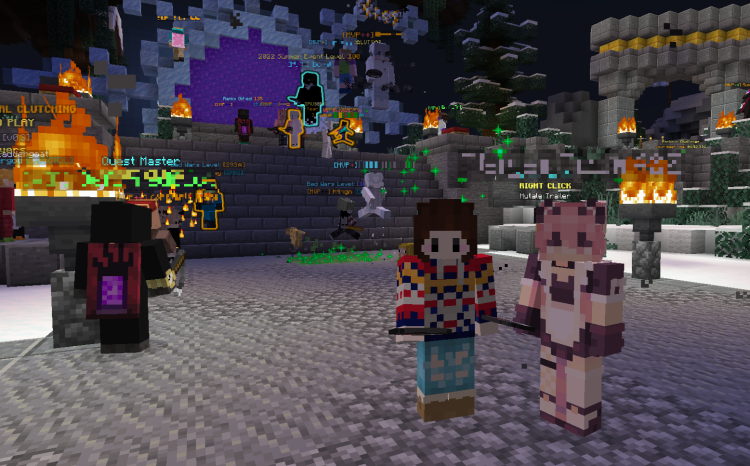Crafting Connections: Autistic Stimmunication in Minecraft by Lina Cahill
While the real world demands “quiet hands,” Minecraft allows us to speak volumes through stims.
By: Lina Cahill
Nominator: Prof. Kira Hall
Course: LING 7800: Neurodiversity in Sociocultural Linguistics
At over 300 million copies sold, Minecraft stands tall among the most beloved and ubiquitous video games of all time. As a defining entry in the sandbox genre, its block-based, near-infinite, three-dimensional worlds invite players from all walks of life to break, take, and build as they please; like a bottomless bin of well-ordered LEGO bricks, this virtual playground offers a structural framework for boundless creativity. Minecraft is also similar to LEGO play in the special appeal it seems to hold for the autistic community, as evidenced by its numerous autism-friendly multiplayer servers and online forums.

Screenshot by Lina Cahill, ca. 2025. I stand, in-game, at the summit of a mountain that overlooks several gorgeous biomes.
Autistic folks often engage in self-stimulatory behavior (stimming) as a method of emotional regulation to alleviate under- and overstimulation. For example, one might tap on a desk to satiate their boredom with tactile sensation—or clap to ventilate their unrest when placed in a crowded room. The term stimmunication positions such self-stimulatory behavior as a form of communication in and of itself, driving against the all-too-common assumption that stims are bereft of meaning. Contrary to the “quiet
hands” mantra of applied behavioral therapies, by which hand stimming is discouraged for its supposed abnormality, stimmunication invites us to consider the role of hands in relaying information; for example, clapping as both a ventilation and exhibition of excitement.

Screenshot by Lina Cahill, ca. 2025. Participant CraftyAndrew and I (foreground, right and left) pose in a public minigame lobby. Andrew has donned their new virtual outfit, reminiscent of a maid café cosplay.
Unlike stimmunication in the real world, which often suffers underrecognition and stigmatization, Minecraft encourages its players to get their stim on.
Minecraft’s text chat outmodes the obstacles of conversational turn-taking and vocal tone interpretation by rendering its interactions as a readable pattern—one grounded in tactile stimulation. Consider how, to vent their frustration, many players spam text chat from the virtual grave after suffering an in-game misfortune or failure (e.g., falling into lava because they miscalculated their leap across a chasm). The ensuing keysmash entails a long string of numbers, letters, and other icons, from which no overt message can be accurately derived; however, it clearly communicates a sense of emotional unrest, especially when preceded by a death alert. On one of our mining escapades, participant Yeti37 was killed by an explosive monster known as a creeper, causing her to lose most of the resources that we had spent the past hour excavating. She proceeded to type “kjijvsbvw43gq3a” in a fit of frustration, which she later clarified in admitting, “I was having a moment.” This impulsive, energetic clap or squirm against the keys was employed for tension dispersal and announcement, in tandem—the frenzied typing both vented her overstimulation and alerted her fellow players, myself included, to her exasperation.
Beyond text chat, the limited avatar flexibility of Minecraft hosts a wide array of stimmunicative, virtually embodied gestures—unintended (but nurtured) consequences of the game’s base moveset. Air punching—in which a player repeatedly clicks the left mouse button to wave their avatar’s arm—exemplifies the deceptive simplicity of these stims. Though invariable when stacked against its real-world counterpart, the Minecraft wave both diffuses and communicates excitement, serving as an eager greeting. This action plays an important role in the game that precedes its communicative possibilities (punching is a primary method of resource acquisition), but it has since been appropriated to serve autistic needs.
On the virtual town square of Minecraft, typing nonsense, jumping up and down, spinning in circles, sticking your butt out, and waving your fist in the air are all well-appreciated (perhaps even integral) interpersonal practices. When clinicians neglect the acutely meaningful elements of such stims, they risk depriving autistic people of our ability to locate ourselves with relation to others and our environments (analogous to stripping a dolphin of their echolocation). Rather than dismissing stimming as deficient or nonexistent communication, Minecraft provides a space in which autistic players can embrace our unique sensitivities and build belonging. In doing so, it serves as a model for how we might enhance autistic acceptance and accommodations in the real world.

Lina Cahill is a graduating senior at the University of Colorado Boulder, double majoring in anthropology and psychology. Outside the classroom, she loves reading manga and doting on her three smelly cats! This fall, she will continue her academic journey at CU as a Ph.D. student in cultural anthropology.


